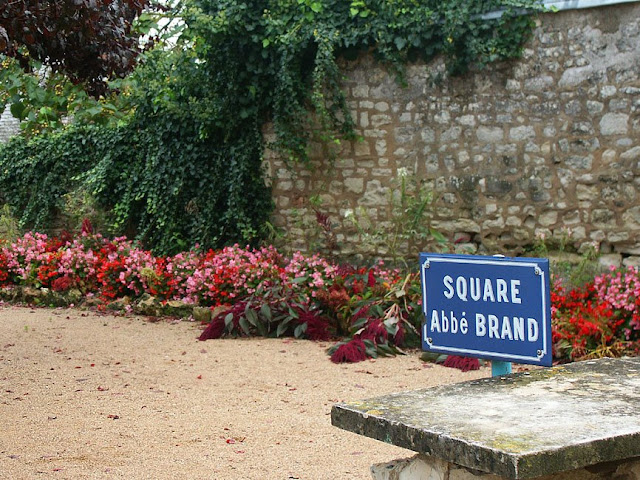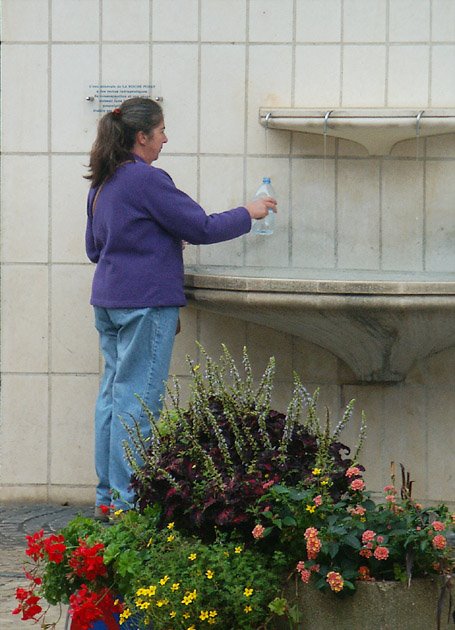This is the second in my series about the French Resistance during the Second World War in the Loire Valley, where I live. It is a story that first gained my attention because my husband shares a family name with the priest, one of the main protagonists. I have pieced the story together from reading eyewitness accounts.

|
|
Square named after Father Brand in La Roche Posay. He went on to become
Bishop of Strazbourg after the War. |
La Roche Posay is a small spa town about a ten minutes car journey from where
I live. The water here is high in selenium and is the basis of skin care
products in l’Oréal’s La Roche Posay range. L’Oréal owns much of the
commercial centre of town and before the Covid19 pandemic there were big plans
announced of a huge investment into the community infrastructure to turn the
town into a luxury spa resort with access to cutting edge skin care
treatments. If you have an intractable skin condition in France, your doctor
may well give you a prescription for two weeks in La Roche Posay to ‘take the
cure’, all paid for by your State health insurance. Visitors to the town’s
spas are known as curistes. But that is today, when all is peaceful,
and I want to tell you about a frightening incident that occurred here 76
years ago, only a day after the liberation of Paris.

|
|
The grave of Resistance fighter, Jacques Martin, just outside La Roche
Posay. |
The Nazi officer in charge of German troops in our area was the notorious
Brigadier General Botho Elster, who is known to be directly responsible for a
number of atrocities. On Sunday 27 August 1944 a German column led by Elster
took 60 people hostage in La Roche Posay. Every year on the anniversary there
is a ceremony of remembrance in the town.

|
|
Me collecting the mineral rich water from the public fountain in La
Roche Posay. |
After the Allied landings in Normandy on 6 June 1944, and following that, in
Provence on 15 August, the German army pulled back towards the East and
crossed the Touraine, south of the Loire, where I live, harassed all the way
by the French Resistance (maquis) and by Allied bombing. Several
thousand Indians had enlisted with the Germans, due to dissatisfaction with
the British, and with the Germans coming to La Roche Posay were Sikh troops
who were particularly encouraged to spread fear amongst the population, partly
just by virtue of their exotically foreign appearance which in rural France
could be enough to cause terror. But they also seemed hellbent on really
overstepping the mark and are reported as entering and occupying private homes
and at times chasing down women and gang raping them (the Director of a nearby
girls school wrote an alarming account). All the enemy troops engaged in
stealing bicycles, carts and horses, burning houses and shooting local men.

|
|
La Roche Posay. |
On that Sunday in August 1944, everything was calm in La Roche-Posay but all too soon it was announced that a German column was coming towards the village. Everyone knew about the recent tragic events of Oradour sur Glane, where the occupants were massacred and the town burned. Some inhabitants of La Roche Posay left at this point, bundles in hand, probably to take refuge in neighbouring farms. With the approach of the column along the Pleumartin road, about 6 pm in the evening, anyone remaining barricaded themselves inside, shutters slammed, and doors locked. Children were sent down to the cellars. When the Germans arrived the cowering people could hear, out in the street, orders shouted, rifle butts beating on the doors, windows being broken. Two German soldiers with a hostage came seeking the 'Burgmeister'. The mayor, Robert Nonnet, immediately realised that they were there for him, and bravely went out to meet them, leaving his two teenage sons hiding in their cellar.

|
|
Summer storm brewing over La Roche Posay. |
Shortly before they reached La Roche-Posay, the German column was attacked by some French Forces of the Interior (FFI) Resistance fighters. In revenge, the Germans burned the nearest farm. They were by then very nervous, and feared further attacks by the Resistance, so they made threats to the local populace. At the Hotel du Parc, where nearly 300 orphaned students from the Herriot School in Strasbourg were refugees, the Germans discovered about 25 men, who were Resisance fighters more or less disguised as school staff. The stressed German soldiers only had one thought at that time, to get across the bridge over the River Creuse at La Roche Posay, then the bridge over the Claise at Preuilly-sur-Claise (where I live), fleeing north. But they feared that the Resistance would destroy the bridges and block their flight, leaving them at risk of being massacred.

|
|
The Hotel du Parc, where the refugee children and Resistance fighters
were sheltering. |
Then the Resistance Corporal Nahola, who was from the French colony of Madagascar, was shot; a local farmer was killed; and around sixty locals taken hostage. Father Brand, chaplain of the Herriot School, intervened with the Germans. He managed to broker a deal with the German Commandant: to contact the Resistance and convince them not to attempt any action in the night and not to destroy the bridge at Preuilly, otherwise the hostages would be executed.
Father Brand then had a meeting with Georges Butruille, one of the leaders of local Resistance, who accepted the deal. He was next brought to an isolated farm where he remained hidden. At La Roche-Posay, the hostages, after questioning, were freed. The mayor saved their lives by vowing that there were no maquisards or FFI among them, which was untrue. The mayor of Preuilly equally put his own life on the line by promising that the Germans would not be subject to guerrilla attacks as they passed through his jurisdiction.
The soldiers of the Elster Column finally left La Roche-Posay, but not without looting houses and having killed a young Resistance fighter from Yzeures sur Creuse, Jacques Martin, who had come to convey a message to his friends. They were finally stopped not very far away but that is another story, for another day. In brief, the Germans had to fight their way through my village, but finally they made it to Beaugency, where the leaders of the French Resistance and the American Airforce General Macon took their surrender on 17 September, on the bridge over the Loire. It was the largest mass surrender of the Second World War.
After the War, Father Brand became Bishop of Strasbourg.
We are also on Instagram, so check us out to see a regularly updated selection of our very best photos.

4 comments:
i didn't know about this. At the time I was with my FFI comrades pursuing the Germans in Burgundy.
I'm fascinated by resistance stories. Thank you
Fascinating as usual, Susan...... I love reading the results of your ferreting!
It creates a bigger picture....
Hello Susan
Smashing piece - comme d'habitude. Before moving to France I thought Cardiff where I was raised had it bad in WWII BUT have changed my mind. At least Germans were not up close and personal.
https://www.bbc.co.uk/blogs/wales/entries/77fdc5f5-906b-341e-a66b-8ab8551c4c7d
Post a Comment